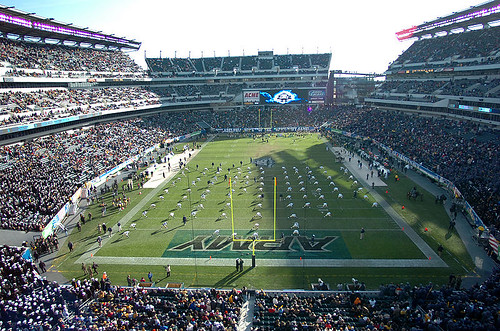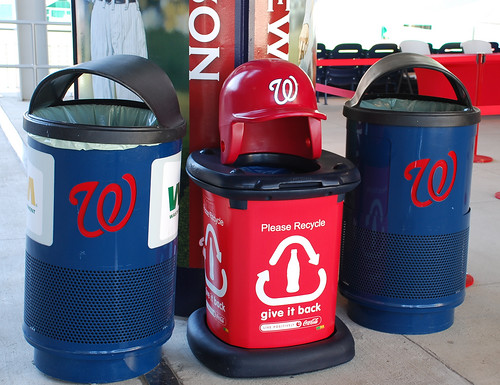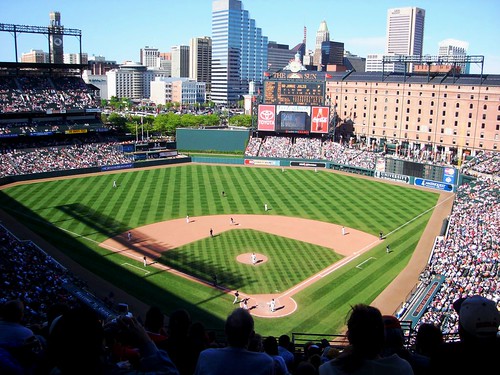How pro sports are helping to green cities

Posted September 12, 2012 at 1:24PM
Lincoln Financial Field, the nation's greenest stadium
Solar panels and recycling bins are becoming as common as hot dog vendors for professional sports teams and their venues, according to a report released last week by my colleagues at the Natural Resources Defense Council, in collaboration with the Green Sports Alliance. The process of putting the industry's operations on a more sustainable course has been ongoing for some time, and it is important: not only is the business of big-time sports highly visible in our culture, but it also can use tremendous environmental resources and generate significant emissions (think lighting at night games, air conditioning in domed stadiums, high-volume traffic getting to and fro). When teams, leagues, and stadiums make significant progress in improving their performance, they deserve our applause.
NRDC's new report, Game Changer: How the Sports Industry is Saving the Environment, documents the collective impact of a range of innovative and cost-effective steps being taken across all professional leagues to go green. My colleague Allen Hershkowitz, director of our organization's green sports project, puts it this way in a press release:
“The motivation for sports to engage in greening is simple; the games we love today were born outdoors, and without clean air to breathe, clean water and a healthy climate, sports would be impossible. A cultural shift in environmental awareness is needed in order for us to address the serious ecological problems we face, and the sports industry, through its own innovative actions, has chosen to lead the way. Pro sports are showing that smart energy, water and recycling practices make sense. They save money and prevent waste. That’s as mainstream and non-partisan as it comes.”
The LA Lakers play in an arena with solar panels
Below are some highlights of teams' greening efforts with regard to energy, water and waste:
Energy:
- Self-sufficiency - Philadelphia’s Lincoln Financial Field, home of the National Football League’s Eagles (their fans have been known to boo Santa Claus, but that’s off-topic), is becoming the first stadium in the US capable of generating 100 percent of its energy on-site through a mix of solar panels, a generator that runs on natural gas and biodiesel and, soon, 14 wind turbines.
- Solar – Staples Center in Los Angeles has a 1,727-panel solar array covering 25,000 square feet of the arena’s roof. The 345.6-kilowatt system supplies 5 to 20 percent of the building’s energy use (depending on load) and produces 525,000 kilowatt-hours annually.
- Wind – In 2012, Cleveland’s Progressive Field became the first pro sports facility to install a wind turbine, which generates more than 40,000 kilowatt hours per year.
Water:
- Irrigation – San Francisco’s AT&T Park has an irrigation “clock” that uses up-to-the-minute local data to establish zone watering times, saving 33-to-50 percent of water for irrigation. Changes in the composition of the infield surface have further reduced field watering by 33 percent.
- Efficiency – The Minnesota Twins’ Target Field installed dual flush toilets and aerated faucets, saving approximately 4.2 million gallons of water annually.
- Water Restoration Credits – For the 2011 Stanley Cup Finals and 2011 Winter Classic, the NHL purchased over 4.5 million gallons in Water Restoration Credits from Bonneville Environmental Foundation to balance the amount of water used during the events. In early 2012, NHL Green introduced Gallons for Goals, committing to restore 1,000 gallons of water to a critically dewatered river in the Northwest for every goal scored during the regular season.
Recycling at DC's Nationals Park
Waste:
- Recycling – The Cleveland Indians have cut their trash in half by implementing an enhanced recycling program. This has also reduced the number of trash pick-ups by 64 percent, saving $50,000 annually.
- Composting – The St. Louis Cardinals’ “4 A Greener Game” program, launched in 2008, is credited with recycling more than 1,836 tons of solid waste, more than 575 tons of yard waste, and more than 110 tons of composted organic material.
- Supply chain impact - The Montreal Canadiens implemented a purchasing policy requiring that the organization buy only environmentally-friendly cleaning products. 80 percent of purchases now include products that are locally made and/or composed of reused or recycled content.
These measures aren't just green: they are also good business. Game Changer documents a number of impressive cost savings analyses from environmental efficiency measures.
In addition to the direct environmental benefits, there is also a tremendous educational dividend to these efforts. While only 13 percent of Americans say they follow science, 61 percent identify themselves as sports fans. Efforts by teams help spread the word, says another NRDC colleague, Darby Hoover:
“If the Cardinals, Eagles, Heat and many other teams can do it for tens of thousands of people every game, [the general public] should be able to start thinking about greening too. You don’t need to be a pro to do this stuff. Recycling and getting smarter with our energy and water use can benefit our household and business budgets too.”
The report doesn’t go into the way that some teams have also helped the environment by rejuvenating older neighborhoods and choosing transit-rich locations, probably because the industry’s record on this aspect is much more mixed. On the negative side, the Dallas Cowboys and Washington Redskins, to name just two teams I am familiar with, use heavily automobile-dependent stadiums plunked down in sprawl. Not much to brag about there. I was a season-ticket holder to the ‘Skins games for many years but finally gave up my seats, in large part because it was such a hassle (literally hours each way) getting there and back. (At least the Cowboys’ old stadium site, demolished two years ago, is planned for conversion to an urban-esque neighborhood; and the Redskins, to their credit, have installed a reported 8,000 solar panels at the stadium to reduce power consumption and associated carbon emissions.)
The Washington Redskins play in a parking lot surrounded by sprawl
But, on the positive side, I’m now a season-ticket holder to Georgetown University basketball. The Hoyas play downtown in the Verizon Center, where the professional Capitals (NHL), Wizards (NBA) and Mystics (WNBA) also play. The arena is within walking distance (or an easy transit ride, if I don’t feel like walking) of my office. The Verizon Center, which was called the MCI Center (don’t get me started on corporate naming practices) when it was originally built by pro sports owner Abe Pollin (“the man who improved downtown”), catalyzed the very impressive rebirth of a long-neglected part of downtown DC.
Similarly, LEED-certified Nationals Park, where the team with the current best record in major league baseball plays, is helping revitalize another centrally located and transit-accessible part of DC, the deteriorated Anacostia River waterfront. (I got slammed by the always-snarky Washington City Paper for saying so, when according to their author the revitalization in that part of town would have happened anyway. Snark aside, they are not completely wrong about that: much of the new redevelopment would have been built at some point in time without the stadium, but I don’t think there’s any question that putting tens of thousands of visitors into the neighborhood 82 times per year helps the business climate there and helps give developers confidence. I think the development has likely been happening faster and to an extent better because of the boost from the stadium.)
Orioles Park at Camden Yards is an urban experience
Not all that many decades ago, Orioles Park at Camden Yards provided the same sort of catalyst for nearby revitalization of Baltimore's Inner Harbor. Heck, the park is so conveniently located that some Orioles team members reportedly commute to the stadium by bicycle.
Meanwhile, all sorts of writers raved about their urban experience at last year’s Super Bowl in Indianapolis, because Lucas Oil Stadium is downtown, within walking distance of amenities and real neighborhoods. As part of the Super Bowl deal, the NFL also funded a youth center in a troubled Indianapolis neighborhood and helped redevelop a downtown street near the city's convention center. For the teams that locate well, there are reduced emissions from driving, reduced costs for infrastructure, and the possibility of helping disinvested neighborhoods come back to life.
Back to Game Changer, the greening practices documented in the report add up to significant improvements to communities' cumulative environmental burdens by reducing waste, water use, and energy consumption, while at the same time helping educate the citizenry about environmental practices. This has almost all happened within the last six years, writes Allen Hershkowitz in his own blog post, with more to come. I can't say that I am without bias on this one, but I have found the report (my colleague Alice Henly was lead author, with significant contributions from Allen and Darby) very well-researched and -written, telling a story that deserves to told. You can download it here.
And, for a fun way to get the message, check out this very lively video on the greening of baseball, other sports, and NRDC’s work on the subject (even Billy Crystal has a cameo appearance):
Related posts:
- 'Baseball-oriented development' hits a home run in DC (May 14, 2012)
- NFL & LISC assist community sports facilities with grant program (July 13, 2011)
- Solving sprawl with basketball (reprise) (February 28, 2011)
- The beautiful game brings dignity to the streets (August 6, 2010)
- Dublin gets spectacular green stadium (June 3, 2010)
- Dallas Cowboys implode for smart growth (April 19, 2010)
Move your cursor over the images for credit information.
Please also visit NRDC’s sustainable communities video channels.




